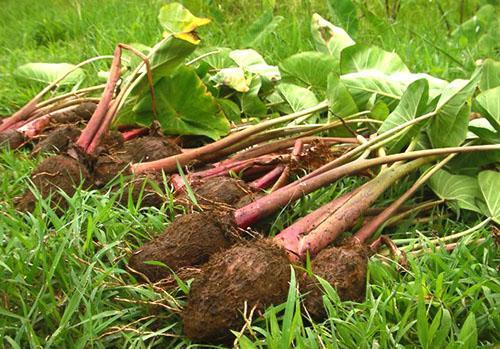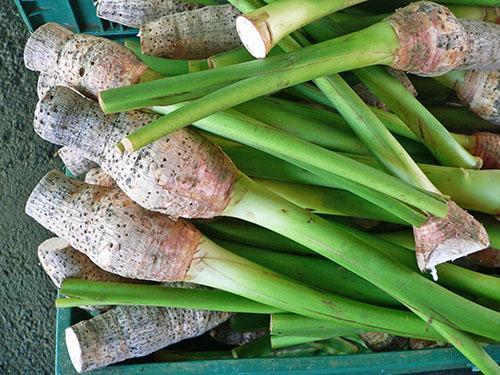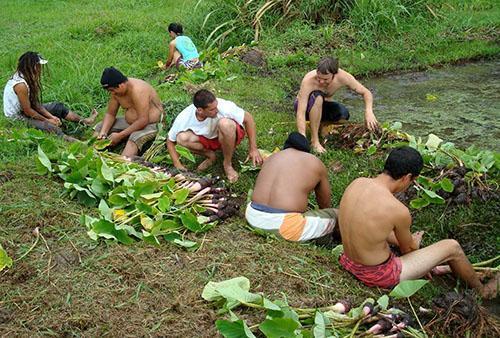What do we know about the amazing root of alocasia?
 Large, cordate or pointed like spearheads, alocasia leaves invariably attract the attention of both beginners and connoisseurs of indoor plants. Florists are attracted by the opportunity to decorate window sills and racks with plants with green, silver and purple foliage, on which bright streaks and contrasting spots are noticeable.
Large, cordate or pointed like spearheads, alocasia leaves invariably attract the attention of both beginners and connoisseurs of indoor plants. Florists are attracted by the opportunity to decorate window sills and racks with plants with green, silver and purple foliage, on which bright streaks and contrasting spots are noticeable.
Alocasia is a very numerous species that unites plants that are unlike either in appearance or in size. But if the first glance of a florist always notes the unusual and spectacular foliage, then it is time to wonder at the arrangement of the underground part of alocasia and its stem, which is a natural continuation of the rhizome.
Both large plants growing up to three meters in height and very small potted types of alocasia consist of:
- from a tuber-like thickened rhizome;
- from a shortened stem;
- from large leaf plates extending from it, holding on to juicy long petioles.
Moreover, it is the root of alocasia that is the source of plant life, an indicator of its health and a means of reproduction.
Alocasia tuber - the heart of the plant

In a tropical climate, on specially prepared plantations, alocasia are grown for 1 to 4 years. During this time, the rhizomes grow, gain weight, and daughter nodules are formed on them. In the process of harvesting from one plant, from 1.8 to 15 kg of alocasia tubers are obtained, which are used as a food product rich in carbohydrates and fiber.
 Despite the presence of a certain amount of cyanide and calcium oxalate in all plants of the aroid family, which has a strong irritating effect, the oblong or oval tubers of alocasia are eaten after cleaning and heat treatment. Do the same with the succulent foliage of Indian alocasia or large-root plants.
Despite the presence of a certain amount of cyanide and calcium oxalate in all plants of the aroid family, which has a strong irritating effect, the oblong or oval tubers of alocasia are eaten after cleaning and heat treatment. Do the same with the succulent foliage of Indian alocasia or large-root plants.
Local peoples, as well as residents of China and Vietnam, repair alocasia as a medicinal plant, in addition, the tubers are also used to produce alcohol.
What is the value of rhizomes? The energy value of 100 grams of alocasia stem tubers, depending on the variety and type of plant, is 293-599 kJ. Moreover, 100 grams of tubers account for:
- 63–81 g of moisture;
- 0.6-3.3 g of protein;
- 0.1-0.2 g of fat;
- 17-27 g of carbohydrates;
- 1.1-1.3 g of ash;
- 46-153 mg of calcium.
In addition, the rhizomes of the plant contain iron, phosphorus, niacin and riboflavin, thiamine and ascorbic acid.
 Unfortunately, most of the species grown as indoor plants have no nutritional value, but they do an excellent job of decorating residential and public spaces.
Unfortunately, most of the species grown as indoor plants have no nutritional value, but they do an excellent job of decorating residential and public spaces.
True, in order for the plant to please the owner with a decent appearance and health, it is extremely important for alocasia to create conditions that resemble those that surround plants at home - in the subtropics and tropics of Asia and Oceania.
Competent care is the key to the beauty and health of alocasia
 Alocasia plants are recommended to be kept in bright, but reflected light. Since there are no direct rays of the sun under the canopy of a tropical forest, in the room they can provoke the appearance of brown or reddish-brown spots on the foliage of alocasia - burns.Plants are also extremely sensitive to dry air.
Alocasia plants are recommended to be kept in bright, but reflected light. Since there are no direct rays of the sun under the canopy of a tropical forest, in the room they can provoke the appearance of brown or reddish-brown spots on the foliage of alocasia - burns.Plants are also extremely sensitive to dry air.
If the ill health of alocasia and its diseases, as on litmus paper, are reflected on the leaves, then the cause often lies underground.
Any damage or discomfort to alocasia tubers affects its well-being. An excessive or improperly organized watering, drying out of the soil and cooling of the soil and the green part of the plant, lack of nutrition and even its excess.
It is not surprising that the question: "What to do if alocasia disappears?" can be heard from many novice florists who have not yet mastered all the requirements of the inhabitants of the tropics. Lovers of exotic plants who are faced with poor pet growth, falling foliage or the appearance of spots of different shapes and colors on it, first of all, should pay attention to the condition of the roots of alocasia and analyze the care of indoor culture.
Between waterings, the soil at a depth of 2–3 cm should dry out, the rest of the lump should maintain uniform moisture.
To do this, not only water the plant in several steps, but also drain all the moisture that has drained into the pan. Alocasia roots are extremely sensitive to both drying out and stagnant water. It is important to take this circumstance into account when the autumn-winter period begins, when the plant needs rest, and its watering is reduced. If this is not done, the risk of developing fungal diseases of alocasia, to which the culture, unfortunately, is very sensitive, cannot be avoided.
 In addition to the fact that warm, settled water is used for watering, attention is also required when feeding a tropical crop.
In addition to the fact that warm, settled water is used for watering, attention is also required when feeding a tropical crop.
If alocasia does not grow or produces deformed small foliage, it is time to support the plant with nitrogen, phosphorus and potassium... The best period for fertilization is the spring and summer months, during which alocasia is actively developing and can release a leaf per week. Alocasia are fed with universal complex compounds, but at a concentration that is two times weaker than for other indoor plants.
In winter, natives of tropical forests cannot be fertilized, otherwise mineral salts trapped in the ground can cause serious burns to the roots of alocasia and its tubers.
Plants prefer air with a temperature of 22–26 ° C. Moreover, its cooling to 12-15 ° C slows down all vital processes, the plant sheds foliage and goes into hibernation. Further cooling is the inevitable death of alocasia tubers, which must be taken into account by flower growers who carry plants to the garden or balcony in the summer.
Symptoms of unhealthy alocasia and its disease
 The situation is aggravated if the alocasia was not only in the flow of cold air, but also the soil in the pot was saturated with moisture. A weakened plant quickly loses its tone and is attacked by pathogenic fungi, putrefactive bacteria and pests. The roots of alocasia take the first blow. Their tissues change color to brownish, soften and collapse. As a result, alocasia itself does not grow, weakens and loses its decorative effect.
The situation is aggravated if the alocasia was not only in the flow of cold air, but also the soil in the pot was saturated with moisture. A weakened plant quickly loses its tone and is attacked by pathogenic fungi, putrefactive bacteria and pests. The roots of alocasia take the first blow. Their tissues change color to brownish, soften and collapse. As a result, alocasia itself does not grow, weakens and loses its decorative effect.
A weakened plant suffers from such alocasia diseases as stem and root rot, spotting, as well as fusarium and late blight. These diseases usually show up as brown or black spots on the leaves. The affected area is surrounded by a yellow or orange halo.
As the infection grows, alocasia loses its foliage, and neither feeding nor other care measures can return the plant to its former beauty.
If the florist detects signs of a disease of alocasia, it is necessary:
- remove damaged and fallen leaves;
- isolate the plant;
- check the condition of the roots and tubers of alocasia;
- somewhat restrict watering and establish care;
- treat the aerial part with a systemic fungicide.
 In a situation where alocasia disease has affected the tuber and the roots extending from it, it is important to remove all rotten parts. And there is no need to worry that alocasia disappears.Even if a significant proportion of the tuber is lost, the plant can be propagated using both parts of the stem and daughter nodules connected to the mother tuber or already growing separately.
In a situation where alocasia disease has affected the tuber and the roots extending from it, it is important to remove all rotten parts. And there is no need to worry that alocasia disappears.Even if a significant proportion of the tuber is lost, the plant can be propagated using both parts of the stem and daughter nodules connected to the mother tuber or already growing separately.
When checking the roots of a diseased specimen, it is important to find such nodules and also process them.
How to propagate alocasia with tubers?
With the help of daughter tubers, it is easiest to get a new alocasia plant. At the same time, a young specimen will retain all the signs of a favorite variety, will be strong and healthy.
 Sometimes sprouts of such "daughters" can be seen in a pot next to the main plant. In this case, the alocasia are simply seated in separate containers, trying not to damage the small nodules and a few more roots.
Sometimes sprouts of such "daughters" can be seen in a pot next to the main plant. In this case, the alocasia are simply seated in separate containers, trying not to damage the small nodules and a few more roots.
If the nodules are attached to a large rhizome or are formed directly on it, they can be planted when at least two leaves appear and a sufficient number of roots for independent life. Before planting in the ground, the tubers of alocasia can be treated with epin, if there is damage on the surface of the rhizome, they are first sprinkled with crushed charcoal or activated carbon.
The soil for the roots of alocasia needs loose, with good oxygen access. And here you can use a mixture of sand, peat and perlite, or ready-made orchid soil. The culture also takes root well in sphagnum, but after the formation of the first roots, alocasia is transferred to the ground.
In order for the tuber to grow faster in a container covered with film, it is important to keep the temperature around 22-24 ° C, and also sometimes ventilate the plantings.
Rooting of the alocasia tuber tip
If an adult plant is severely rotted, or the alocasia does not grow for some other reason, such as being over 4 years old, the specimen can be renewed by cutting and rooting the top.
 All leaves are removed from the plant, and then with a sharp blade the upper part of the stem is separated without traces of rot and mechanical damage. The cut is treated with coal powder and dried for an hour. The resulting stalk can be rooted in a loose mixture of peat and sand, while the plant must be covered with a film.
All leaves are removed from the plant, and then with a sharp blade the upper part of the stem is separated without traces of rot and mechanical damage. The cut is treated with coal powder and dried for an hour. The resulting stalk can be rooted in a loose mixture of peat and sand, while the plant must be covered with a film.
 After a couple of weeks, you should wait for the formation of roots, which means that it is time to transplant the cutting into a mixture of sphagnum moss with garden soil. After acclimatization, healthy young leaves soon appear on such a plant.
After a couple of weeks, you should wait for the formation of roots, which means that it is time to transplant the cutting into a mixture of sphagnum moss with garden soil. After acclimatization, healthy young leaves soon appear on such a plant.
 You can force the alocasia to give aerial roots before the tip is removed by wrapping the trunk with moist moss. After a month, healthy rhizomes appear under such a "bandage", which facilitates the transplantation and reproduction of the culture.
You can force the alocasia to give aerial roots before the tip is removed by wrapping the trunk with moist moss. After a month, healthy rhizomes appear under such a "bandage", which facilitates the transplantation and reproduction of the culture.
If the upper part of the alocasia tuber is cut from a healthy specimen, the part remaining in the soil will definitely give new leaves and continue to grow.
Even part of the rhizome can give life to a new plant if it has at least one dormant bud. Such a cutting is treated with coal powder, and, if necessary, with a fungicide, and then transplanted into separate containers.